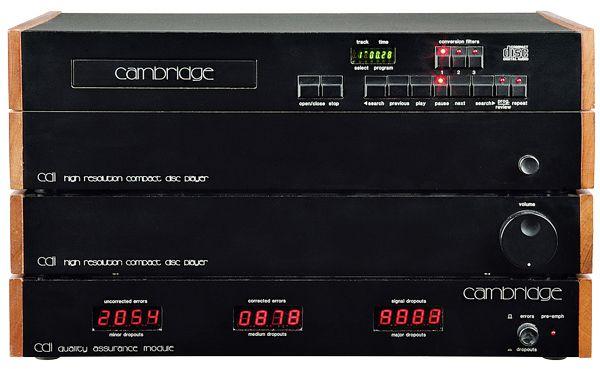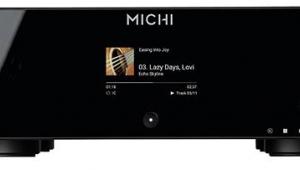Cambridge Audio CD1 (Vintage)

The engineer in question was Stan Curtis of Cambridge Audio and the result of his labours was the CD1 player. Introduced in 1984, it effectively changed the face of CD reproduction – and not just due to its multi-box construction.
Bass was a particular area of concern, as Curtis felt that players generally were not reproducing the low-end information of which the CD was theoretically capable. He also concluded that the main problems were actually coming from the beginning of the chain: the laser scanning mechanism.
Curtis observed that many of the parts making up a CD transport were of relatively poor quality. As a result, the rotating disc often vibrated, moving up and down and making the servo’s job much harder than it needed to be.
So he devised a proper isolation set-up for the laser system with the laser mounted on a spring and rubber damper; this, in turn, was fitted to a lead beam suspension.
Measurements showed a huge reduction in reading errors with this suspension, it also formed the basis of the third box in the full CD1 set-up – the optional Quality Assurance Module, which showed error rates. Now the error correction capabilities of the player could concentrate on correcting data issues from the disc itself, rather than faults introduced by the scanning system.
From his work with Cambridge Audio’s amplifiers, Curtis realised the importance of the power supply in the chain and he specified three transformers: one each for the control circuits, logic, and the analogue output stage. The DAC implementation was also rather more novel than existing designs.
Finally, the integrator stage of the CD1 was spread over three circuits, each with relatively low gain and minimal filtering to minimise distortions. This was followed by a filter section with selectable options and a high quality analogue output stage.
Locked into the beat
Whereas many players of the time sound shrill, thin and somewhat fatiguing, the CD1 is a very different beast. It has a fulsome sense of authority and positively bounds along when fed a good beat.
With Mark Knopfler’s Golden Heart [Vertigo] we were impressed by the sheer punch and impact of the drum beats during the introduction to ‘No Cannibals’. When the track broke into its stride, the Cambridge CD1 again locked onto the beat and the bass, overlaying the vocals on top very neatly indeed. The vocals themselves were also well rendered.
Once again, the backbeat to tracks like ‘Still The Only One’ from the Webb Sisters’ Daylight Crossing [Mercury] was firm and taut, but accompanied by a fine sense of space around instruments. Treble was also delightfully clean and crisp, but without any of the associated glare and hardness that can mar the experience of early digital products.
It soon became apparent that this ‘musicality’ transcended genre and artist. Grand classical pieces thundered around the room with pomp and fervour, delicately tapped jazz hi-hats had our feet stirring instantly, while simple vocal material proved emotive and delightful. The latter was showcased well by ‘Laura’ from The Haunted Man [EMI]. Here, Natasha Khan’s plaintive vocals were a delight, if delivered with a slight underlying lack of absolute purity. What was beyond reproach was the beautifully rendered backing piano.
Verdict
The Cambridge Audio CD1 was a landmark product and instantly made other players sound dated – quite a feat when they were only two years old! Even today it is a highly entertaining listen, despite having a few rough edges.
Originally published in the 2014 Yearbook
























































